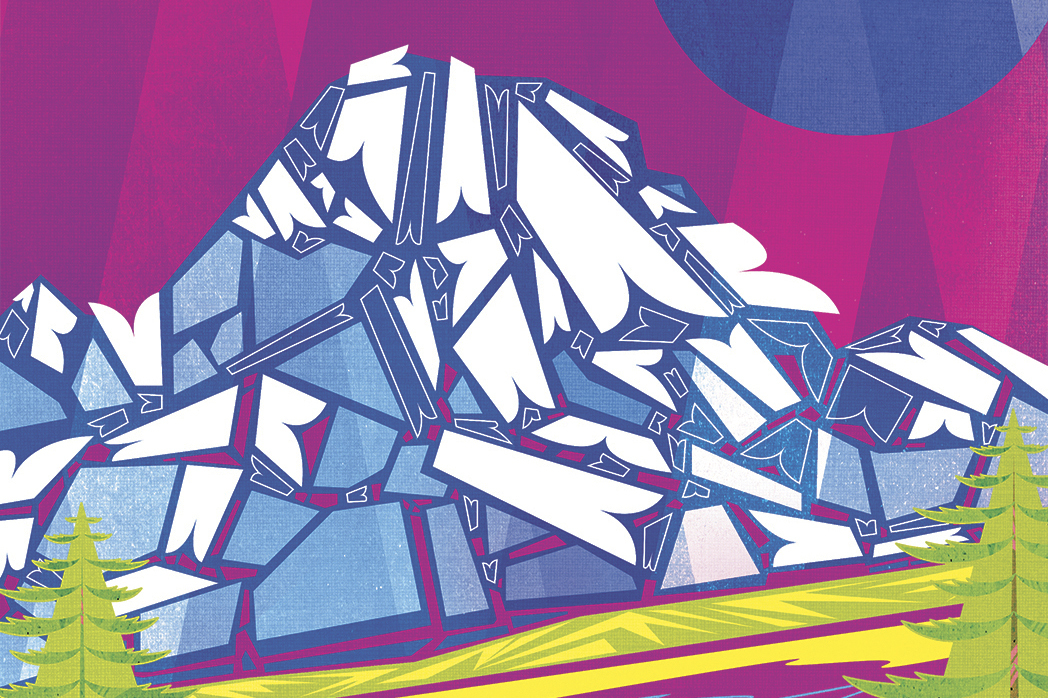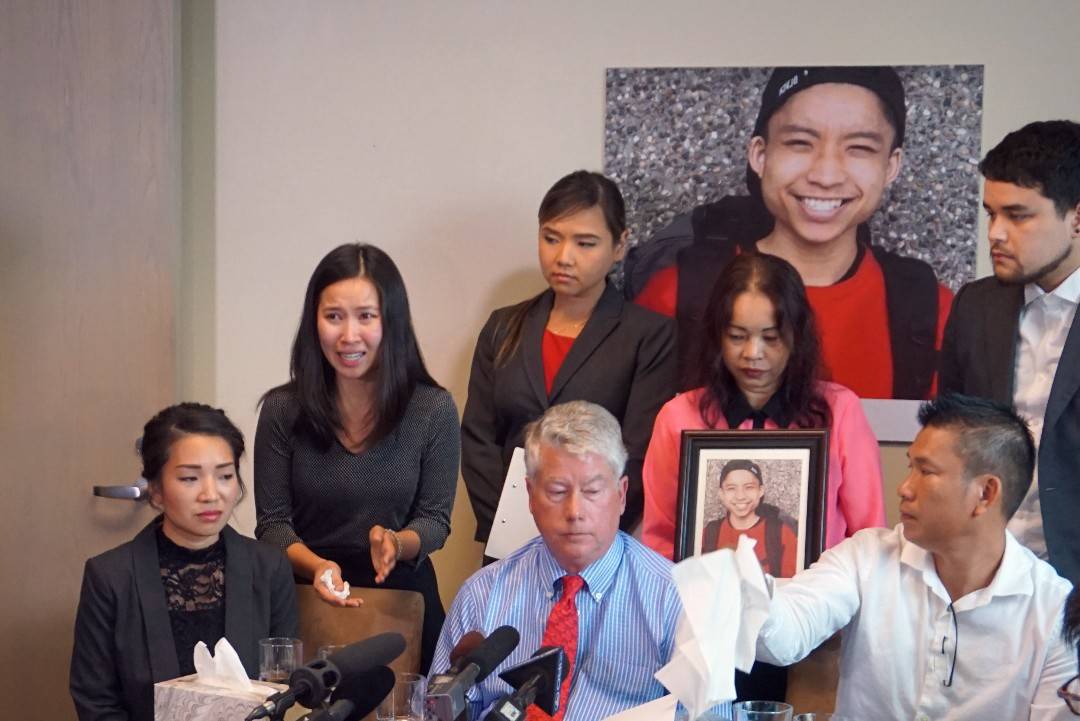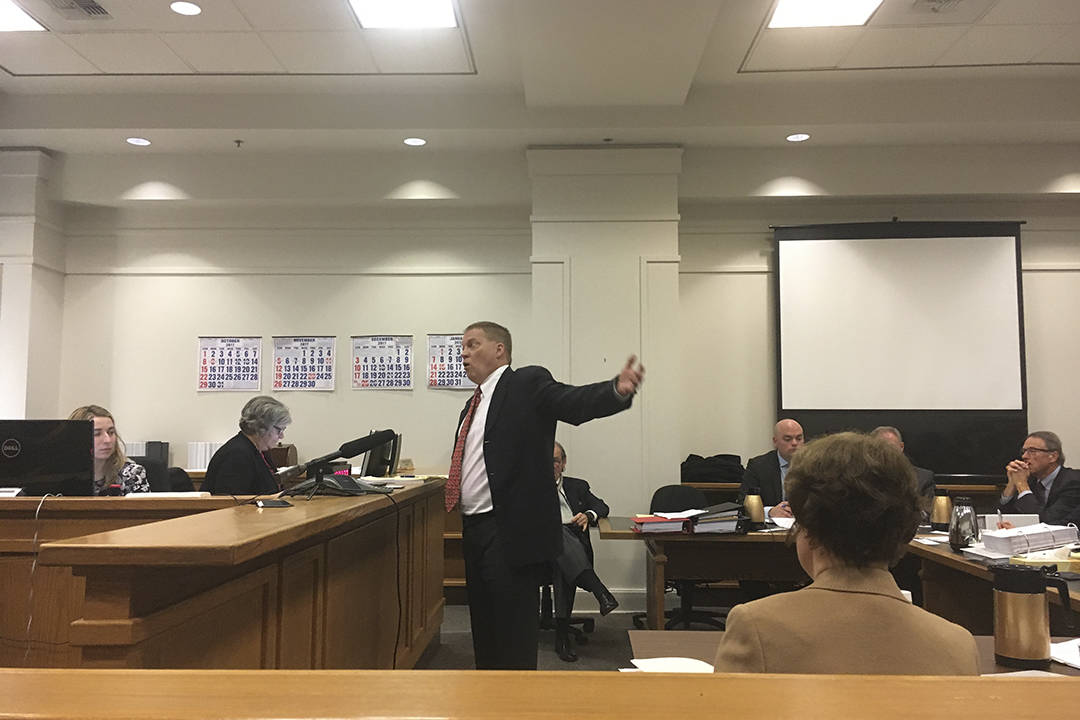When he was growing up, Dave Burlingame’s mother would sometimes take him and his siblings out of school to drive around Mount Rainier.
“We’re going to go out and look at our stuff,” Burlingame, an enrolled member of the Cowlitz Tribe of Indians, remembers her saying. “I didn’t know what that meant at the time.”
In time, he would learn. Through ancient family stories told by his elders, he learned of trips his ancestors took up the snowy slopes to gather huckleberries and other resources.
In one story, his family “stayed too long, and they heard a growl. The old man wanted his mountain back,” he says, keeping the story vague, as family histories are considered sacred in Cowlitz culture. “We have family legends that deal with this stuff, the entire story.”
Intimate though these stories are to Burlingame and his family, for many decades there existed, in both academic and popular circles, an open question as to whether, and how often, the first peoples of the Pacific Northwest traveled into the high country of the Cascades.
Legendary Seattle climber Fred Beckey summed up the general consensus of Native use of the high country in his 2003 book Range of Glaciers: “In an environment of almost continuous seasonal rain and dense forests, the mountainous landscape probably held only a periodic interest for hunting, fishing, and berry-picking.”
The view that it made little sense for tribes to expend the energy needed to climb the sheer, austere mountains that ring Puget Sound has long been supported by a lack of evidence that they ever tried.
“We always maintained that we had a presence up at Mount Rainier, but there wasn’t any proof,” Burlingame says.
But in the past 10 years, an enormous amount of evidence uncovered by archaeologists in Mount Rainier and North Cascades national parks has greatly altered that narrative. In Mount Rainier—which as late as 1994 hadn’t even conducted a systematic survey on what kind of archeological sites might be within its boundaries—more than 100 sites have uncovered evidence of prehistoric uses of the mountain, the vast majority of them in the peak’s high subalpine reaches. Major sites have been discovered on both the mountain’s east and west sides, suggesting tribes from both sides were familiar with the environment. Meanwhile, geological and carbon dating have placed humans on Rainier millennia earlier than previously theorized—about 9,000 years.
Such ancient use “at an alpine site, above the elevation of some of the glaciers around it, was a real revelation,” says Bob Mierendorf, the longtime archaeologist at North Cascades National Park, who has found evidence of equally ancient use in those mountains. “From the very earliest times, people must have been familiar with the alpine. They spent time in it, they traveled it. So we now have all this evidence that there is this whole alpine, mountain aspect to [indigenous] people’s long history.”
The discoveries are particularly satisfying for people like Burlingame, who now serves as the cultural-resources director for the Cowlitz Tribe. “It’s finally proof of what we’ve been telling people—that we’ve been using this mountain for ages and ages,” he says. “Unfortunately we have to wait for science to bear out what we already know. Even though oral history is considered viable … it doesn’t always come to light until there are actual physical things that have been found that say, yep, this has been what we’ve been telling you.”
The lion’s shareof our archaeological understanding of the area containing Mount Rainier National Park is attributed to the work of Greg Burtchard, who last month retired as the park’s staff archaeologist. Burtchard grew up in the Four Corners area of northwestern New Mexico, and as a boy hiked among some of the most abundant caches of Native American-built features and artifacts in the country. That ignited his imagination about what came before European settlement of the West.
His interest in the Cascades began when he headed the Laboratory of Archaeology and Anthropology at Portland State University, in the shadow of Mount Hood, in the late ’80s. One reason scientists had assumed early peoples did not spend a lot of time in the mountains here was that they believed the mountains were resource-poor. But as he explored Hood, hiking among ample berries and big game, Burtchard realized that was a flawed analysis, to say the least. It made less and less sense to him that indigenous peoples wouldn’t avail themselves of the rich bounty that it would have provided in the summertime.
However, there was very little evidence with which to test the idea. Owing to the widely held assumption that early peoples did not use the high country much, few archaeologists had bothered to look—a scientific negative feedback loop that stretched for decades.
“There was an unintentional but fairly pervasive bias in archaeological research and investigations to orient toward the lowlands,” says Mierendorf, who started his archaeological study of North Cascades National Park in 1984 and was then developing similar ideas about long-term mountain use. “It’s a logical outcome, and a natural thing when you think about archaeologists going to do their work where archaeological sites are most obvious… . But all of that tended to leave the mountains out. Not that there weren’t tantalizing pieces of evidence everywhere, including the testimony of Indian elders on the importance of the mountains out there.”
Burtchard notes that by the time whites began arriving in the region in large numbers, local tribes had been decimated by disease. As a result, settlers did not have a clear picture of what indigenous Pacific Northwest life was like prior to European settlement, further skewing modern understanding of the mountains. Put in historical context, settlers arrived in a “more or less empty landscape.”
Back in Portland, Burtchard began to hypothesize about what archaeologists could expect to find on Mount Hood and in other Cascade mountain environments if they were to conduct field surveys. First, based on research showing that permanent fishing villages with large populations began to appear in the Pacific Northwest around 3,500 years ago, he predicted that artifacts in the mountains would begin to appear in the same time period; by his logic, only in a society where a large number of people needed to be fed would it make sense to endure the trials of traveling into rugged mountain areas to reap what they had to offer. He also predicted that most archaeological sites would be found in the subalpine sweet spot above the thick forests—which are difficult to hunt and gather in—but below the barren alpine rock fields that have little food to offer.
He left Portland State in 1990, his model not fully tested, but five years later—following a sojourn to Hawaii involving, among other things, studying how the Polynesians came to inhabit those islands—he got a chance to further develop his ideas on Northwest mountain land-use patterns when he won a contract with Mount Rainier to conduct an inventory of its precontact archaeological resources—a systematic survey of the park plus an examination of all the places on the mountain trail crews and other workers had come across rock flakings, arrowheads, and other evidence of early humans.
During the inventory, it occurred to Burtchard that Rainier would be a perfect place to produce solid scientific evidence against which he could test his theories of alpine use by early peoples. Thanks to the Cascade Range’s penchant for repeated volcanic eruptions, layers of volcanic ash can provide scientists a valuable calendar by which to measure when artifacts were left on the ground. And due to the vagaries of wind patterns, Rainier has been especially good at capturing the ash of other mountains’ explosions, meaning that across much of the mountain, to dig into the ground would be to see epochs demarcated by stratified ash layers. Lastly, on account of Rainier’s high perch over the surrounding mountains, any artifacts found there would clearly indicate people traveling to the mountain as a destination, rather than simply passing through to get from one side of the Pacific Crest to the other.
With that in mind, five years after conducting the inventory, he applied for and accepted the opportunity to move here permanently to become the park’s archaeologist. “I thought, ‘You’ve got a great laboratory here.’ Mount Rainier is almost an island. You don’t go to Rainier to go somewhere else. It’s always been a destination location, a mountain resort, if you will,” Burtchard says today. “That’s why I moved here from a perfectly good job in Hawaii to a cold, rainy place.”
The move proved fruitful. Among Burtchard’s first significant research sites was a place called Buck Lake, in the northeast part of the park. It sits at an elevation of 5,400 feet amid patchy stands of trees and open meadows—the precise type of subalpine environment where Burtchard predicted archaeologists would find mountain artifacts.
In partnership with the Muckleshoot Indian Tribe and the International Archaeological Research Institute in Hawaii, Mount Rainier staff and volunteers spent five years conducting archaeological tests of the area, during which they recovered thousands of pieces of chipped stone debitage (the waste flakes left behind when stone tools are repaired), an array of abandoned fire hearths, and other features and artifacts sandwiched between volcanic ash layers from repeated eruptions of Mount Rainier and Mount Saint Helens. Unsexy and time-consuming though these explorations may sound, they were hugely significant in understanding how long people have been making the upslope journey to Mount Rainier.
In the first year of research, 2005, researchers found stone flaking dating back about 3,500 years—a date matching the earliest site then known in Rainier and more or less conforming to Burtchard’s prediction of the onset of alpine use. The next year, however, researchers found human artifacts about 5,500 years old, suggesting that mountain environments were used longer than Burtchard had expected. Just a year later, the team recovered the first artifact that predated the Mazama volcanic eruption (the one that created Crater Lake) of 7,950 years ago—twice as early as Burtchard had predicted.
Burtchard says he was stunned by the findings, and still gets goosebumps thinking about the discovery. Yes, it disproved his model of early use of Pacific Northwest mountains, “but that’s such a cool way to be wrong.”
In total, more than 20,000 artifacts were found at the Buck Lake site spanning about 9,000 of years of human use, suggesting far more than occasional use by early people. In 2010 and 2011, Burtchard and his team investigated another trove of artifacts on the opposite side of the park, near a place called Forgotten Creek. Again, chipped tool-stone flakes were found below the Mazama eruption. Then, in 2014 and 2015, the archaeologists uncovered yet another major site, this one at a lower elevation in the park’s southwest corner. Once more, the artifacts predated the Mazama eruption.
To sum up: In 2007, Mount Rainier National Park had no confirmed human presence prior to 3,500 years ago; today, three sites in the park date as far back as 9,000 years. And with so many sites, scattered across such a wide swath of the mountain, to Burtchard, the conclusion is clear: “8,000-plus years, three separate spots: Clearly, these people were using the landscape widely and early.”
Further strengthening Burtchard’s case—and vice versa—were discoveries in the park by Mierendorf, the North Cascades archaeologist. At a site on Cascade Pass, his team has uncovered artifacts dating back 9,700 years. They include small cooking pits, which Mierendorf says suggest that people were not simply passing through the high Cascades, but staying there for an extended period. “Until we found this,” Mierendorf says, “there was always a question, an essential question: Are the mountains marginal” to early human archaeology? The answer, he now says confidently, is no.
Meirendorf is especially interested in ways the discoveries expand modern understanding of Salish history, which is often only discussed in a coastal context. “We tend to see our data as really, really expanding the true story of Salish people’s involvement in this landscape,” he says. “We’ve got a whole subculture to explore, a whole aspect of Salish people that goes beyond salt water and canoe people.”
With widespread and heavy human use of the highlands established, the next question becomes: Why were they there? To answer that, archaeologists must leave their field of expertise and borrow from other, softer disciplines.
In his telling of the story of early people’s use of the high country, Burtchard prefers to stick to what you might call an economic interpretation of the data. Astute as people may have been at mountain travel, there’s no denying that it was still difficult to reach Mount Rainier in the days before highways cut their way up its face. Burtchard reasons there must have been a strong, resource-driven incentive to travel there; that incentive, he says, lies in the summer bounty of Rainier’s subalpine meadows.
“The subalpine and even alpine zones are resource-rich,” he says. “That’s where the elk are, the grouse are, the glacier lilies, the huckleberries; and a bit higher up, the mountain goats.” The teeth of mountain beavers and mountain goats have been found at archaeological sites, suggesting those animals were hunted—possibly for their warm coats and pelts, valuable for lowland winters.
Simply put, humans need to eat and stay warm, and the Pacific Northwest’s subalpine environment fills that need; that, says Burtchard, goes a long way toward explaining why humans have traveled there for so long. His data appears to back up the theory: Of 115 prehistoric sites in Rainier, 92 percent of them are in the subalpine—the same place as most of the food.
Mierendorf agrees that mountain resources are important to the story, but argues that there is a spiritual dimension to the mountains that is equally important—specifically, the tradition of spirit-questing in Salish cultures. “Greg tends to be a little more focused on consumable resources, what puts food on the table. I acknowledge that, but it alone is not sufficient to describe all the usage,” he says. “I also see spirituality as important.”
Burlingame, of the Cowlitz Tribe, agrees that the spiritual aspect of native mountain life is primary. “We did lots of spiritual work for ourselves and our families up there,” he says. “You’d go as far up as you could, and used that to search for our answers on a personal level.”
Regardless of what brought people up into the mountains, the discoveries of the past 10 years have helped establish a framework that is strengthening connections between local tribes and the park. “For Greg, part of learning about the prehistory of the park and the long-term use of it,” says Rainier National Park Superintendent Randy King, is knowing that “the descendants of those people are here today.”
In addition to his service as the park archaeologist, Burtchard was also the tribal liaison for the park, and has continued to work in a similar capacity even since retiring. In 2014 he led an effort to establish campsites near Longmire on the banks of the Nisqually River, in the southwest part of the park, for designated use by members of the Nisqually Indian Tribe. These campsites recognize the long-term use of the region by tribal people and honor the traditional presence there of the Nisqually people after whom the river was named.
Following the extensive discoveries last year in the southeast portion of the park, a similar effort is underway with the Cowlitz Indian Tribe, whose traditional lands are nearby and who consulted on the recent archaeological project from the outset.
“With this archaeology in hand, we are pursing the same course” as the Nisqually, Burlingame says. “It gives us a place where we can always camp there, do whatever cultural work or spiritual work needs to be done.”
Burtchard, Burlingame says, has been “really good about protecting the heritage, so that our stories have truth to it now, so they’re not just stories. They are facts.”
dperson@seattleweekly.com








